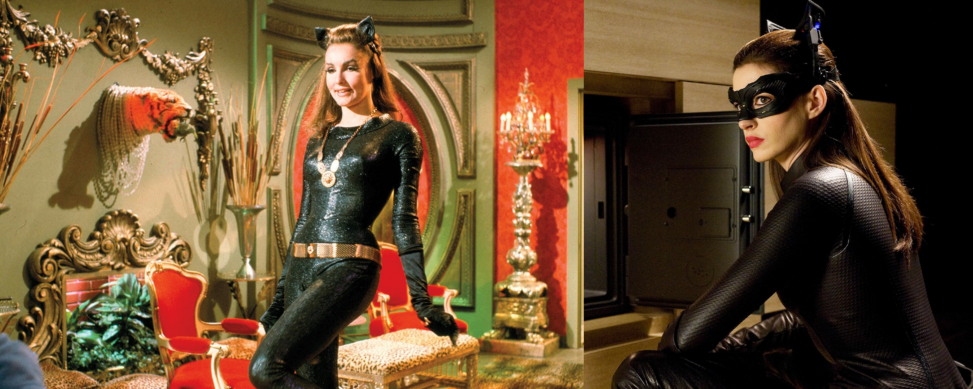Over the years of cultural arts, many female heroines/villains have made big changes in their appearance and character. In recent entertainment history, we have seen many different minorities that are not the straight white males go from struggling to have a character taken seriously by the audience due to how they are written, to being written not only properly, but fairly as well. This is a prime example of something we see in superhero movies and comic books in the Marvel and DC world, as we are more used to seeing strong masculine men saving the world than a female heroine; this goes with villains as well. When writers attempt to write an evil villain, the dominant hegemony we look at is the idea of female villains being highlighted under a “sexy” lens; being a big portion of their character. Taking Cat Woman for example, we can take a look at how female villains over time in cultural frameworks of entertainment turn into nuanced anti-heros that are taken more seriously.
The first example we use to explain this evolution is Julie Newmar’s version of Catwoman in the 1960’s Batman TV Series. Newmar’s version of Catwoman was more often witty and seductive, using Batman’s weak edge of attraction to her advantage, rather than her using any strength or empowering capabilities. She was in a sleek black costume that exercised the character’s strongest power being lustful bait. This problem was a build up of events coming from years back, attempting to make women feel like being the submissive, lustful counterpart to the heroic male is just as fair; when it is not. This was negatively impactful to any women who watched this character and felt as if this character is portraying how women should act to become empowering. Not only is this morally incorrect, it becomes a domino effect leading to a bigger problem that needs to be tackled. The post-war insecurities of the male gender being worried about the feminine role moving into a more powerful position had created these issues in mass media. From Barnes-Smith who wrote about this issue, “The femme fatale… embodies post-war fears that women, having contributed mightily to the war effort and moved into ‘men’s work,’ might abandon the domestic sphere entirely… Even the most powerful men around her can’t comprehend or control the violent forces she represents” (Barnes-Smith, 2015). Dominant male culture at this point in time was very worried about losing their masculine and empowering hegemony, so they created “empowering” female characters who demonstrated what the white male wanted the role to look like as a tactic to bring back the dominated traditional standard.
Anne Hathaway’s portrayal of Catwoman in the 2012 “The Dark Knight Rises” came with a more practical approach with more self motivational purpose. This time around, Catwoman has more focus on being survival driven and fending for herself rather than being seen as having the primary focus on being seductive. Her suit becomes more practical as well, rather than being just covered in black latex for the male viewership. Rewriting her in this way helps untangle the problem of females being represented incorrectly. The issue can even go as far as when a female villain is meant to be taken seriously, male dominant ideology can still get in the way of it. “The portrayal of female villains as both empowered and monstrous highlights society’s discomfort with autonomous women, where their strength is often reframed as a form of threat” (Shahid and Sayyid 2024). Upon taking the time to understand this, it gives the clear view that female characters have been boxed into a stereotype for so long that there’s a discomfort with multimedia and visual culture challenging it. “The modern female villain often retains the allure of the traditional femme fatale while subverting it, adding layers of complexity that reveal societal critiques… combining charm and agency to challenge the viewer’s perception of femininity and evil” As this does need to be challenged and unnormalized, leaving it would keep causing women to feel as though they are not as useful or empowered as the male gender.
By rewriting Catwoman as an anti-hero with more color and meaningful screen time, the recreation was not only necessary, but mandatory for social justice and equality. This becomes almost a domino effect for other blockbuster movies to do the same thing in making feminine roles more diverse and socially acceptable to not only the male gender.
Citation Sources
Barnes-Smith, Danielle L. Fatal Woman, Revisited: Understanding Female Stereotypes in Film Noir. Undergraduate Honors Thesis, University of Montana, 2015. https://scholarworks.umt.edu/utpp/38.
Shahid, Anka, and Amal Sayyid. “Unveiling Corporeal Feminism: Deconstructing Female Villain Archetypes in Maleficent.” Pakistan Languages and Humanities Review 8, no. 1 (2024): 386–394. https://doi.org/10.47205/plhr.2024(8-I)35.
Guerrero, Barbara. “Representing Modern Female Villain: On Feminine Evil, Perverse Nationhood, and Opposition in Rómulo Gallegos’ Doña Bárbara and Salman Rushdie’s Midnight’s Children.” Master’s thesis, University of Western Ontario, 2016. https://ir.lib.uwo.ca/etd/4266/.
Images:
”All of the Stars Who Have Played Catwoman.” E! Online. October 28, 2024. https://www.eonline.com/photos/34026/all-of-the-stars-who-have-played-catwoman.
Julie Newmar as Catwoman.” Emmys. October 28, 2024. https://www.emmys.com/sites/default/files/styles/slider_images/public/photos-article/julie-newmar-catwoman-1170×780.jpg?itok=uAVUXu-k.


Mainul Islam
Your analysis of Catwoman’s transformation from a seductive villain to an empowered, versatile anti-hero is perfectly reflected in your study. You present her as a symbol of advancement by analyzing how her persona defies conventional representations of gender, highlighting her freedom and moral complexity. The analysis might be strengthened by highlighting the cultural relevance of her development and demonstrating how Catwoman’s story reflects society’s developing respect for female strength and independence. The significance of her transformation would be further demonstrated by taking into account the reactions of the audience, not only for her character but also for the strong statement it makes regarding the shifting gender roles in the modern world. The images that you chose for your analysis were also perfectly fitting your topic as we can see the more suggestive posture of the Julie Newmar’s version and the more modern take of Anne Hathaway’s version of catwoman.